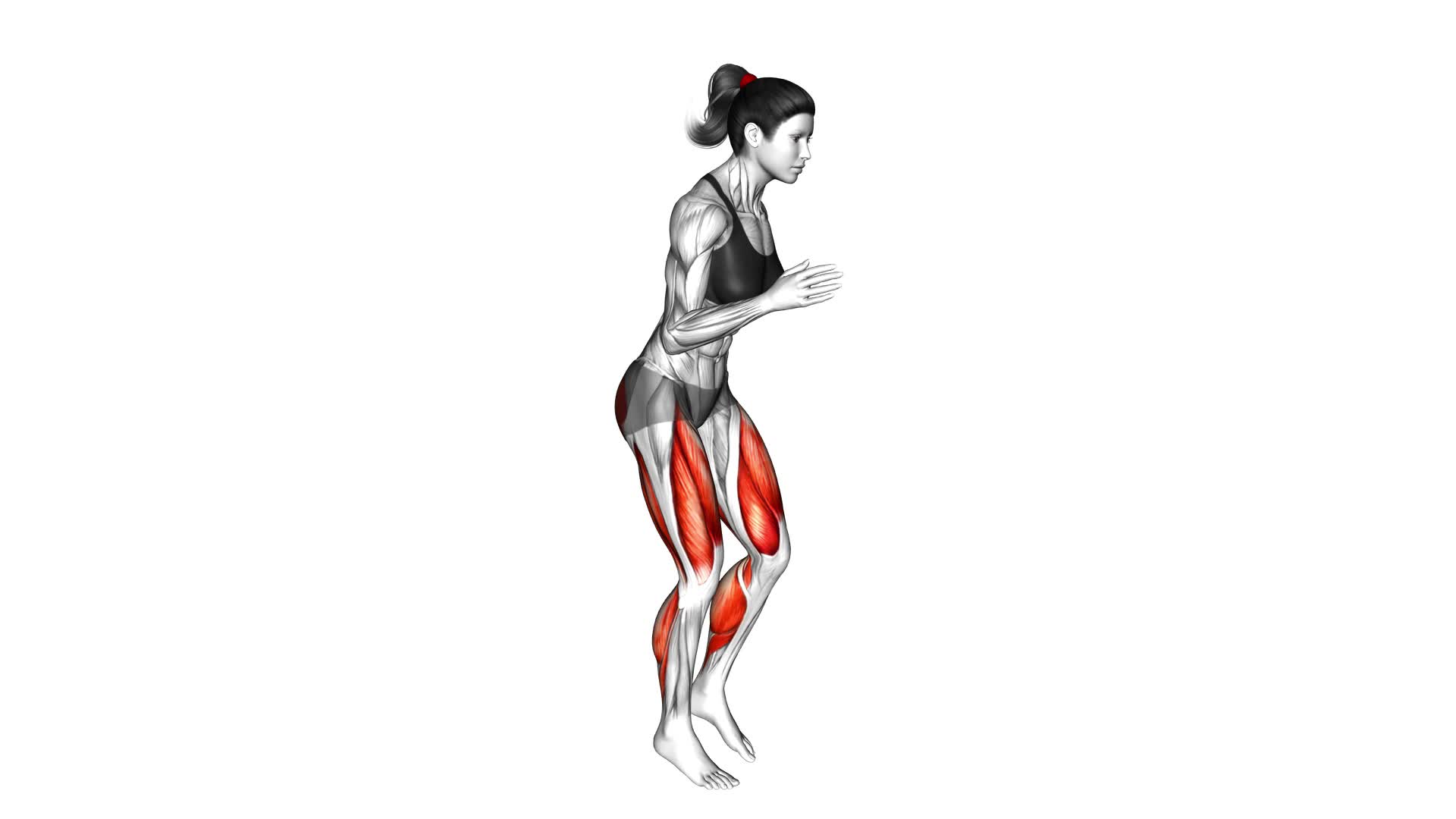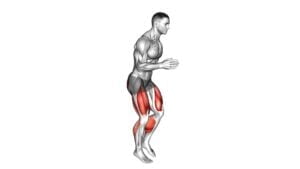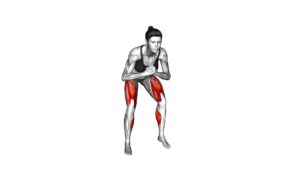Quick Feet Run (female) – Video Exercise Guide & Tips

Get ready to amp up your workout routine with the Quick Feet Run! This high-energy exercise is perfect for boosting your cardio endurance and burning calories.
Watch This Exercise Video
In this video exercise guide, we'll show you proper form and technique, as well as variations and progressions to challenge yourself. With our helpful tips, you'll maximize your results and take your fitness to the next level.
So lace up your sneakers and get ready to feel the burn!
Key Takeaways
- Quick Feet Run boosts cardio endurance and improves cardiovascular fitness.
- Proper form and technique, including speed and foot placement, are crucial for the Quick Feet Run.
- Preparing for the Quick Feet Run should include dynamic warm-up exercises such as High Knees, Butt Kicks, Lateral Lunges, and Ankle Circles.
- To maximize results, maintain proper form, pump arms in sync with foot movements, incorporate quick feet into different workouts, and be consistent with Quick Feet Run workouts.
Benefits of the Quick Feet Run
Get ready to experience the many benefits of the Quick Feet Run. This exercise isn't only great for weight loss but also for improving your cardiovascular endurance. The Quick Feet Run involves fast movements, requiring you to move your feet quickly in a running motion. This high-intensity exercise helps to burn calories and shed unwanted pounds, making it an excellent choice for those looking to lose weight.
When you perform the Quick Feet Run, you engage multiple muscle groups, including your legs, glutes, and core. This full-body workout helps to tone and strengthen your muscles, resulting in a leaner and more defined physique. Additionally, the fast-paced nature of this exercise elevates your heart rate, improving your cardiovascular fitness over time.
Incorporating the Quick Feet Run into your regular exercise routine can have a significant impact on your overall health and well-being. Not only will you see improvements in your physical appearance, but you'll also experience increased energy levels and enhanced endurance.
Proper Form and Technique
To ensure proper form and technique during the Quick Feet Run, it's important to consistently and consciously focus on the speed and placement of your foot movements. This exercise is all about quickness and agility, so make sure to keep your feet moving rapidly and maintain a steady rhythm.
One common mistake is taking too large steps, which can throw off your balance and slow you down. Instead, aim for short, quick steps that allow you to stay light on your feet.
Another common mistake isn't fully engaging your core muscles. Remember to keep your core tight and your body upright to maximize power and stability.
Proper form and technique are crucial in preventing common injuries such as ankle sprains or shin splints. Avoid rolling your ankles by maintaining proper foot alignment and landing softly on the balls of your feet.
Additionally, ensure that you warm up properly before starting the exercise and listen to your body to avoid overexertion.
Preparing for the Quick Feet Run
To effectively prepare for the Quick Feet Run, you should incorporate dynamic warm-up exercises into your routine. A proper pre-run warm-up helps to increase blood flow, loosen up muscles, and prevent injuries. Here are four essential warm-up exercises to include in your routine:
- High Knees: Stand tall and lift your knees as high as possible, alternating between legs. This exercise warms up your hip flexors and engages your core.
- Butt Kicks: While jogging in place, try to touch your heels to your glutes. This exercise loosens up your quads and hamstrings, preparing them for the quick movements of the Quick Feet Run.
- Lateral Lunges: Take a wide step to the side and lower your body into a lunge position, keeping your knee aligned with your toes. Alternate sides to stretch and activate your inner and outer thighs.
- Ankle Circles: Sit down and extend one leg in front of you. Rotate your ankle in circles, both clockwise and counterclockwise, to improve ankle mobility and prevent sprains.
By incorporating these dynamic warm-up exercises into your routine, you'll enhance your performance and reduce the risk of injury.
Now that you have properly prepared, it's time to explore the variations and progressions of the Quick Feet Run.
Variations and Progressions
Once you have completed the dynamic warm-up exercises and properly prepared your body, it's time to explore the various variations and progressions of the Quick Feet Run. As you become more comfortable with the basic movement, you can challenge yourself by incorporating advanced techniques to enhance your agility, speed, and coordination.
One advanced technique you can try is adding lateral movements to your Quick Feet Run. Instead of moving forward and backward, you can incorporate side-to-side movements, taking quick steps to the left and then to the right. This will engage different muscle groups and further improve your overall agility.
Another variation is to increase the speed of your footwork. Challenge yourself to move your feet as fast as possible while maintaining control and proper form. This won't only improve your speed but also test your endurance and cardiovascular fitness.
It's important to be aware of common mistakes that people often make when performing the Quick Feet Run. One common mistake is stomping the feet too hard on the ground, which can lead to unnecessary stress on the joints. Remember to keep your movements light and quick, focusing on speed rather than force.
In the next section, we'll provide you with tips for maximizing your results and getting the most out of your Quick Feet Run. By incorporating these variations and avoiding common mistakes, you'll be well on your way to improving your agility, speed, and overall athletic performance.
Tips for Maximizing Your Results
To maximize your results with the Quick Feet Run, focus on maintaining proper form and technique throughout the exercise. Here are some tips to help you get the most out of your workout:
- Avoid common mistakes: One common mistake is lifting your feet too high off the ground. This can cause unnecessary strain on your legs and decrease the effectiveness of the exercise. Instead, focus on quick, low-to-the-ground movements.
Another mistake is letting your arms hang loose. Engage your upper body by pumping your arms in sync with your foot movements. This won't only increase your speed but also provide a full-body workout.
- Incorporate quick feet into different workouts: The Quick Feet Run can be integrated into various workouts to add intensity and challenge. Try adding it to your cardio routine by incorporating short bursts of quick feet between running or cycling intervals. You can also use it as a warm-up exercise before strength training to activate your leg muscles and improve your overall performance.
- Stay consistent: To see the best results, it's important to be consistent with your Quick Feet Run workouts. Aim to incorporate this exercise into your routine at least 2-3 times a week. Consistency will help improve your speed, agility, and endurance over time.
- Push yourself: Remember to challenge yourself during each session. As you become more comfortable with the exercise, try increasing the speed and intensity of your movements. Pushing yourself out of your comfort zone will lead to greater improvements in your fitness level.
Frequently Asked Questions
How Long Should I Perform the Quick Feet Run Exercise for to See Results?
To see results from the quick feet run exercise, you should perform it for at least 20-30 minutes, three times a week.
Tracking your progress is important to evaluate your improvement. You can use a stopwatch or a fitness tracker to measure your time and try to beat it each session.
Incorporating the quick feet run into a full body workout routine will increase its effectiveness and help you achieve your fitness goals faster.
Keep pushing yourself and you'll see the results you desire!
Can the Quick Feet Run Exercise Help Me Improve My Speed and Agility for Sports?
Improving your athletic performance is a top priority, and the quick feet run exercise can definitely help you with that.
By incorporating quick feet training into your routine, you can enhance your speed and agility for sports.
This exercise works on your footwork and coordination, allowing you to react faster and move more efficiently on the field or court.
The benefits of quick feet training are immense, so get ready to take your game to the next level!
Is It Necessary to Warm up Before Performing the Quick Feet Run Exercise?
Before you start the Quick Feet Run exercise, it's essential to warm up. Warming up helps increase blood flow to your muscles, preventing injuries and preparing your body for the workout.
Additionally, warming up improves your performance by enhancing your flexibility and range of motion. Remember to focus on proper form and technique while performing the exercise to maximize its benefits.
Stay motivated and enjoy the rewards of improved speed and agility in your sports activities.
Can the Quick Feet Run Exercise Help in Burning Calories and Losing Weight?
The Quick Feet Run exercise is a great way to burn calories and lose weight. By incorporating this high-intensity exercise into your routine, you can increase your heart rate, boost your metabolism, and shed those extra pounds.
The Quick Feet Run for Weight Loss is an effective cardio workout that targets multiple muscle groups and helps you achieve your weight loss goals.
Are There Any Modifications or Alternatives for Individuals With Knee or Ankle Injuries?
If you have knee or ankle injuries, don't worry! There are modifications and alternatives available for you.
When it comes to knee injury modifications, you can try low-impact exercises like swimming or cycling.
As for ankle injury alternatives, exercises that focus on upper body strength, like seated dumbbell presses or bicep curls, can be great options.
Remember, it's important to listen to your body and consult with a healthcare professional before starting any new exercise routine.
Stay motivated and keep pushing forward!
Conclusion
Incorporating the quick feet run into your exercise routine can provide numerous benefits. This includes improved agility, speed, and cardiovascular endurance.
By maintaining proper form and technique, you can maximize your results and reduce the risk of injury. Remember to prepare your body adequately before attempting this exercise and gradually progress to more challenging variations.
Stay motivated and consistent in your training to achieve your fitness goals. Enjoy the rewards of a stronger, more agile body.
Keep up the great work!

Author
Years ago, the spark of my life’s passion ignited in my mind the moment I stepped into the local gym for the first time. The inaugural bead of perspiration, the initial endeavor, the very first surge of endorphins, and a sense of pride that washed over me post-workout marked the beginning of my deep-seated interest in strength sports, fitness, and sports nutrition. This very curiosity blossomed rapidly into a profound fascination, propelling me to earn a Master’s degree in Physical Education from the Academy of Physical Education in Krakow, followed by a Sports Manager diploma from the Jagiellonian University. My journey of growth led me to gain more specialized qualifications, such as being a certified personal trainer with a focus on sports dietetics, a lifeguard, and an instructor for wellness and corrective gymnastics. Theoretical knowledge paired seamlessly with practical experience, reinforcing my belief that the transformation of individuals under my guidance was also a reflection of my personal growth. This belief holds true even today. Each day, I strive to push the boundaries and explore new realms. These realms gently elevate me to greater heights. The unique combination of passion for my field and the continuous quest for growth fuels my drive to break new ground.







